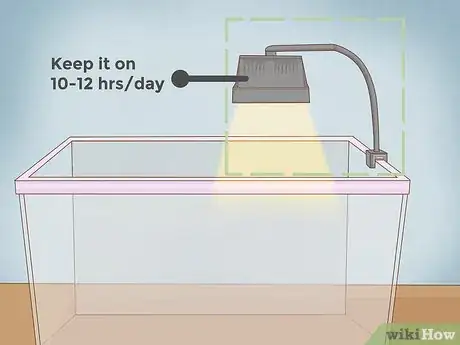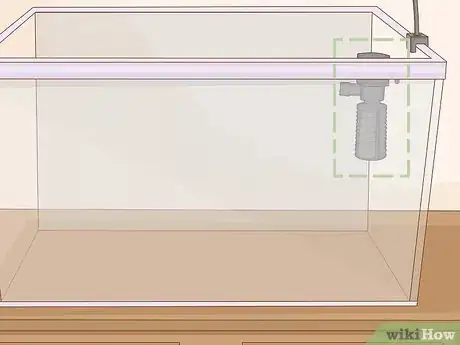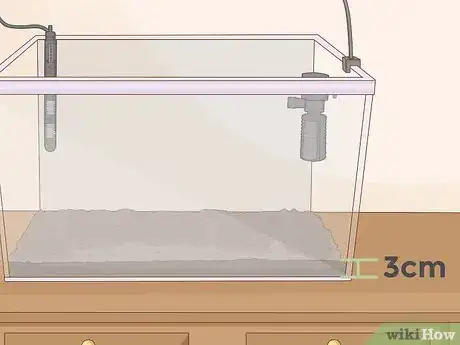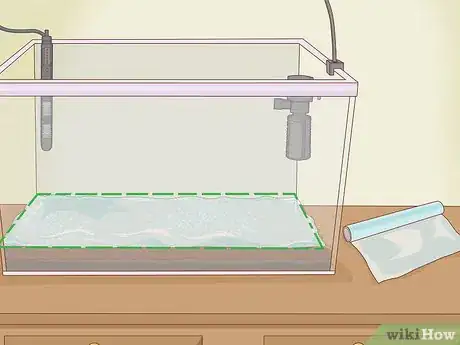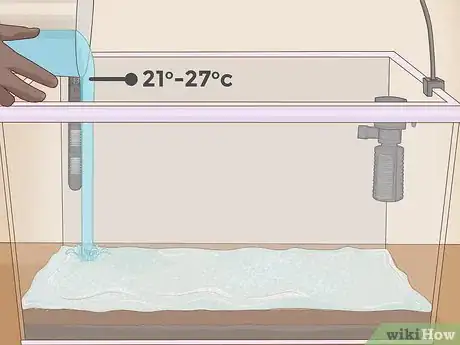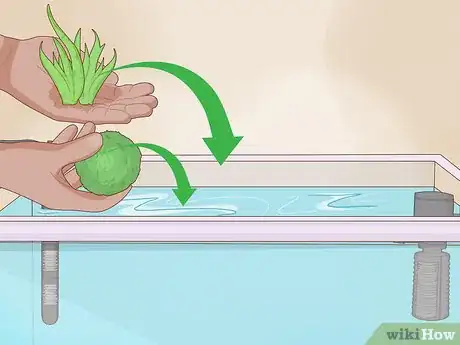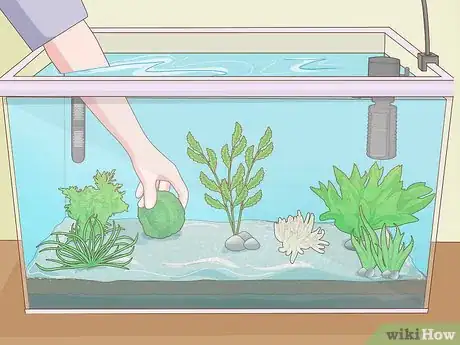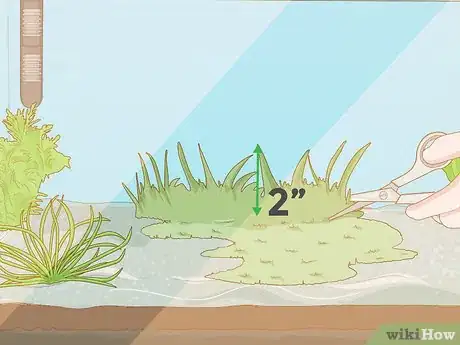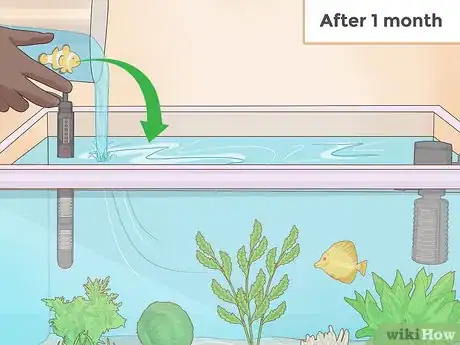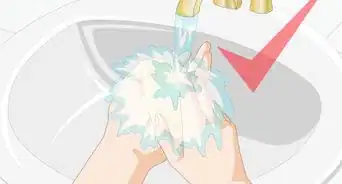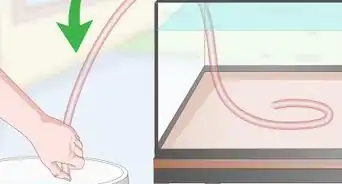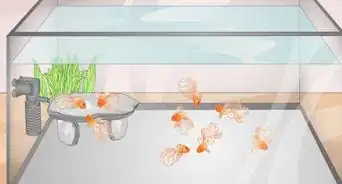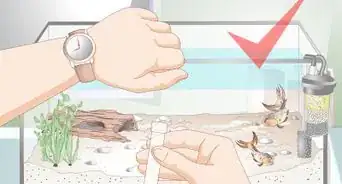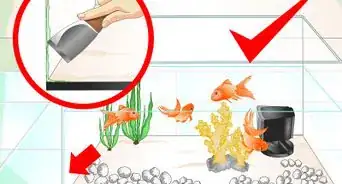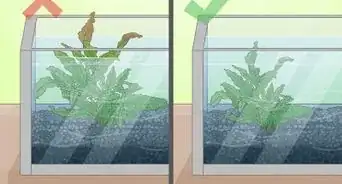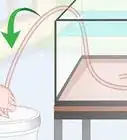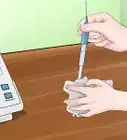This article was co-authored by Doug Ludemann. Doug Ludemann is the owner and operator of Fish Geeks, LLC, an aquarium services company based in Minneapolis, Minnesota. Doug has worked in the aquarium and fish-care industry for over 20 years, including having worked as a professional aquarist for the Minnesota Zoo and Shedd Aquarium in Chicago. He received his Bachelor of Science in Ecology, Evolution, and Behavior from the University of Minnesota.
There are 7 references cited in this article, which can be found at the bottom of the page.
This article has been viewed 200,628 times.
Live plants are added to an aquarium to give it a natural look and can help to regulate and filter the water as well. It may seem simple, but live plants can be difficult to add to an aquarium if you don't have the correct setup and tools to help them thrive. Whichever plants you choose to add to the aquarium, your fish and aquatic animals will feel a little more at home in the scenery.
Steps
Setting up an Aquarium
-
1Buy a tank that will house your pets and choose a place to keep it. Check the tank size requirements for your aquatic animal before you buy an aquarium, then choose a suitable place in the home to set it down away from direct sunlight. You can buy aquariums and indeed all of your aquatic pet supplies at just about every major pet store or local exotic pet store.[1] Remember that you will fill it with water, substrate, and live plants, so don't keep it on a rickety or unbalanced surface.
- 1 US gal (3.8 L) of water weighs about 8 lb (3.6 kg), so a 10 US gal (38 L) tank with gravel and decor will weigh significantly more than an empty tank.
-
2Set up a specialty light bulb above the cage to help the plants thrive.[2] LED lights and fluorescent lights are the best options to use as they emit little heat and provide light for the plants to convert into energy.[3] Set up a lightbulb so it lights the aquarium without directly beaming light into your animals' eyes — if it's too bright for you to look at, it is too bright for your pet, so use a low setting.
- Avoid using incandescent light bulbs as they do not penetrate the water effectively and will not give any nutrients to your live plants.
- You should keep the light on for about 10 to 12 hours each day at the max.
Advertisement -
3Pick a filter that is made for the size of your tank and the plants you will add. Aquariums under 50 gallons (190 L) will be just fine with a small filter unit attached to the back of the tank, but heavier aquariums will need a stronger filter.[4] The substrate you will add later on will help to filter the water somewhat, but the water filter unit keeps the water clean and helps your plants to thrive.
- Opt for a heavy-duty filter, such as a canister filter, if you are worried about your plants dying. While a small filter will suffice for a light aquarium, a filter built for heavier tanks will clean the water more efficiently and you won't have to change it out as much.
-
4Set up a water heater, if your fish and aquatic animals require warm water.[5] Some animals will do perfectly well in non-heated water, while others need the water to be warm and inviting. Look up what conditions are optimal for your fish or aquatic animal, and buy a heater that will keep it maintained at that temperature.[6]
Laying Substrate in the Tank
-
1Clean and lay sand 3 cm (1.2 in) thick on the tank's bottom. Run the sand under water in a pillowcase or ultra-fine mesh container until the water comes out clean.[7] Pour the sand gently into the bottom of the aquarium so it creates a medium-thick layer at the bottom.
- The sand will filter water, provide nutrients to plants, and create a place for bottom feeding animals to dig and bury themselves.[8]
- Avoid using gravel, as it contains no nutrients needed for live plants. Gravel is a common choice for aquariums that don't have live plants as it is easy to clean and easy to handle. However, for live plants, gravel provides no nutrition and colored gravel can actually make the water more acidic.[9]
- If you must use gravel, opt for fine gravel over chunks of gravel, as you can mix it with sand or another substrate to provide some level of nutrition. This is not advised if you plan on having more than a few plants in the aquarium.
-
2Pour a 3 cm (1.2 in) layer of plant substrate over the sand carefully. There are a variety of substrates available at all pet and aquarium stores, and it doesn't really matter which brand you choose as long as it contains no gravel.[10] Look for products that are clay-based to mix with the sand and look for products that are advertised as being live-plant-friendly.
- Clay-based substrate will make it easier to anchor and root your plants, while other substrates may provide additional nutrition.
- Look for substrates that contain plant fertilizer, or mix the substrate with plant fertilizer before you add any plants to the aquarium.[11]
-
3Cover the substrate layer with a plastic sheet or an easily removable cover. The sheet should cover the majority of the substrate layer as you fill the aquarium so you don't disturb it. Use a long piece of plastic wrap, a plastic tub cover, or a pot lid for spherical aquariums.
-
4Fill the tank with room temperature water slowly and carefully. The water should be anywhere from 70–80 °F (21–27 °C) to create the right conditions for most underwater vegetation.[12] Slowly and carefully fill the tank with water, being sure to avoid disturbing the substrate layer too much.
- Your plastic cover or lid will help spread out the impact from having water poured over the base layer.
- Check the temperature requirements for both your aquatic animal and your live plants. 70–80 °F (21–27 °C) is recommended for most fauna and fish, but if your plants require it to be higher or lower, use whichever temperature is recommended.
Choosing Plants for Your Aquarium
-
1Find plants that are compatible with your aquatic pets.[13] Generally, mosses and grasses are compatible with all aquatic pets, but you should check the care sheet or information guide that came with your pet to see which plants should be avoided and which ones they prefer.[14]
- For example, in a seawater enclosure, clownfish love anemone. In freshwater enclosures, you should avoid planting leafy plants if you have goldfish or snails.
-
2Look for plants that fit inside the aquarium without coming out of the water. Depending on the size of your aquarium, you will have either a lot of options to choose from or a limited selection. Tall plants are not suitable for short aquariums because the part of the plant outside the water will not survive, whereas tiny plants may become lost in the scenery in a large aquarium.[15]
- Moss and grasses are great in almost any aquarium, so be sure to include these in your tank.
- If your cage is longer than it is wide, consider planting some frilly and wide ferns as opposed to stemmed plants that continually grow.
-
3Vary the size and location of plants to improve the scenery's aesthetic. Some plants are better to put in specific areas in the tank for the aesthetic and scenic purposes. For example, short plants should be located at the front, while tall plants should be at the back so as not to disrupt the view. Common groupings of aquatic plants include carpeting plants, foreground plants, mid-ground plants, and background plants.[16]
- Carpeting plants: Carpeting plants will spread across the substrate layer and create a lush "carpet" of vegetation. Java moss, hair grass, and other mosses and grasses are easy to plant and take care of.
- Foreground plants: Foreground plants are placed in the front of the aquarium, and add a sense of depth and scenery to the tank. Water Wisteria, Pygmy Swords, and other short but frilly plants are great options.
- Mid-ground plants: Mid-ground plants are thick, tall, and fill out the natural scenery in the tank. Mid-ground plants include African Water Ferns, Java Ferns, and other plants that take up lots of space and spread out.
- Background plants: Background plants are placed at the back of the cage and are often the tallest and most obstructive vegetation. Amazon Swords, Anubias, and other towering and flowering plants are popular choices.
Planting and Taking Care of Live Plants
-
1Remove your plant from its container and set it in the substrate layer. Take care not to damage the plant as you remove it from its packaging, and carefully plant it in the substrate according to the planting instructions.[17] Different types of plants require different depths to be planted in the substrate — some common methods for different plant types include:
- Mosses and Grasses: Turn off the filter, and place the moss directly on top of the substrate in areas you want it to grow. Place a heavy coin, such as a half dollar or pound coin, on top of the moss to keep it down while the roots grow into the substrate over the next week.
- Potted plants: Remove the plant from the plot and be careful to not damage the roots poking out of the bottom of the dirt or cotton. Dig a hole in the substrate as wide as the plant, place it inside, and then blend in the sides of the plant with substrate.
- Ferns: Attach the fern to a rock or piece of driftwood with a fishing wire or cotton thread to keep it upright. Ferns do not need to be placed in the substrate layer, most just need something solid to hold onto for stability. Cotton thread will dissolve with time, whereas fishing wire should be cut away and removed once the fern takes hold.
- Plants with a stem: Push the base of the stem about 1–2 in (2.5–5.1 cm) into the substrate and it should stay upright. If not, use a fishing wire or cotton thread to keep it up until it can support itself. You can plant stemmy plants all in one area in a frilly bunch, or spread them around the back and middle areas.
-
2Trim your plants regularly to encourage their growth and survival. Plants of all kinds can quickly become too big and take up too many resources in the tank for their own good. Use a very sharp knife to cut away dead leaves, dead stems, and trim the grass or moss in the tank every time you clean the aquarium.[18]
- Moss can be re-planted in other areas of the tank, if you wish, by simply placing it onto an empty patch of substrate and weighing it down with a heavy coin until the roots take hold.
- Take about 2 in (5.1 cm) off of the top of a stemmed plant to encourage its growth when it gets to reach the top of the water level.
-
3Let the tank cycle water for about 1 month before you introduce your fish. Substrate, plants, and everything else you've put into the aquarium can change the acidity, nutrient content, and overall healthiness of the tank. Allow the tank to cycle water normally through the filter, remove algae and buildup, and allow the plants to take root before you introduce fish and aquatic animals.[19]
- The tank needs time to build up nutrients and beneficial bacteria in the substrate. This beneficial bacteria helps to stabilize the tank and prevents ammonia and nitrate build up.
- Especially with bottom feeding and burrowing aquatic animals, it is important to let your plants get to the point that they can support themselves before you introduce new creatures. Some aquatic pets will dig at the base of plants, or eat leaves and stems, so you give your plant the best chance of survival if you allow it to take root.
Expert Q&A
Did you know you can get expert answers for this article?
Unlock expert answers by supporting wikiHow
-
QuestionWhat should I keep a close eye on when growing live aquarium plants?
 Doug LudemannDoug Ludemann is the owner and operator of Fish Geeks, LLC, an aquarium services company based in Minneapolis, Minnesota. Doug has worked in the aquarium and fish-care industry for over 20 years, including having worked as a professional aquarist for the Minnesota Zoo and Shedd Aquarium in Chicago. He received his Bachelor of Science in Ecology, Evolution, and Behavior from the University of Minnesota.
Doug LudemannDoug Ludemann is the owner and operator of Fish Geeks, LLC, an aquarium services company based in Minneapolis, Minnesota. Doug has worked in the aquarium and fish-care industry for over 20 years, including having worked as a professional aquarist for the Minnesota Zoo and Shedd Aquarium in Chicago. He received his Bachelor of Science in Ecology, Evolution, and Behavior from the University of Minnesota.
Professional Aquarist I would say number one, you've got to worry about your CO2. In a literal sense, CO2 concentration, water, carbonate hardness or alkalinity, and pH are mathematically linked. You can't change one without changing the others. if you are dosing your plants with CO2, which I highly recommend that you do, you should also be monitoring your alkalinity and your pH levels.
I would say number one, you've got to worry about your CO2. In a literal sense, CO2 concentration, water, carbonate hardness or alkalinity, and pH are mathematically linked. You can't change one without changing the others. if you are dosing your plants with CO2, which I highly recommend that you do, you should also be monitoring your alkalinity and your pH levels. -
QuestionWhat should I do after I receive my live plants in the mail?
 Terry SheltonCommunity AnswerRinse them in tank water and plant them.
Terry SheltonCommunity AnswerRinse them in tank water and plant them. -
QuestionWhich is the best plant to keep in the aquarium?
 Shadow_wolf_52Community AnswerIt depends. Java Fern and Java Moss are common, low maintenance, and usually low cost too, but plants like Amazon Sword look cool. Always make sure you have enough room in your tank for a plant, but it really depends on what you want.
Shadow_wolf_52Community AnswerIt depends. Java Fern and Java Moss are common, low maintenance, and usually low cost too, but plants like Amazon Sword look cool. Always make sure you have enough room in your tank for a plant, but it really depends on what you want.
Things You'll Need
- Aquarium
- Filter
- Heater
- Sand and Substrate
- Various underwater plants
- A thermometer
- Light source
References
- ↑ https://www.buildyouraquarium.com/setting-up-planted-aquarium/
- ↑ Doug Ludemann. Aquarium Care Professional. Expert Interview. 27 August 2019.
- ↑ http://injaf.org/articles-guides/beginners-guides/beginners-guide-to-aquarium-plants/
- ↑ http://injaf.org/articles-guides/beginners-guides/beginners-guide-to-aquarium-plants/
- ↑ Doug Ludemann. Aquarium Care Professional. Expert Interview. 27 August 2019.
- ↑ https://www.buildyouraquarium.com/setting-up-planted-aquarium/
- ↑ http://injaf.org/articles-guides/beginners-guides/beginners-guide-to-aquarium-plants/
- ↑ http://injaf.org/articles-guides/beginners-guides/beginners-guide-to-aquarium-plants/
- ↑ https://www.buildyouraquarium.com/setting-up-planted-aquarium/
- ↑ https://blog.aquariuminfo.org/the-best-planted-tank-substrates/
- ↑ https://blog.aquariuminfo.org/the-best-planted-tank-substrates/#Substrates_Overview
- ↑ https://www.buildyouraquarium.com/setting-up-planted-aquarium/
- ↑ Doug Ludemann. Aquarium Care Professional. Expert Interview. 27 August 2019.
- ↑ http://aquaticplants.animal-world.com/SelectionandPlantingPlants.htm#TypesOfAquaticPlants
- ↑ http://aquaticplants.animal-world.com/SelectionandPlantingPlants.htm#TypesOfAquaticPlants
- ↑ http://aquaticplants.animal-world.com/SelectionandPlantingPlants.htm#TypesOfAquaticPlants
- ↑ http://injaf.org/articles-guides/beginners-guides/beginners-guide-to-aquarium-plants/
- ↑ https://aquariuminfo.org/trimming.html
- ↑ https://www.buildyouraquarium.com/setting-up-planted-aquarium/
About This Article
To set up an aquarium with live plants, start by lining the bottom of the aquarium with sand and a layer of plant substrate. Then, fill the tank with room temperature water. Next, choose some live plants that are compatible with the fish you'll be keeping, and make sure they're small enough that they won't be poking out of the top of the water. Finally, bury the roots of the plants in the substrate at the bottom of the tank, and cycle the tank for 1 month before introducing any fish. For tips on how to choose a good light and filter for live aquarium plants, read on!

